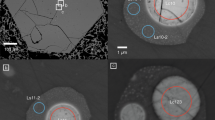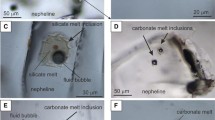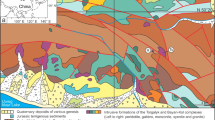Abstract
This paper reviews the results of investigations of melt inclusions in minerals of carbonatites and spatially associated silicate rocks genetically related to various deep-seated undersaturated silicate magmas of alkaline ultrabasic, alkaline basic, lamproitic, and kimberlitic compositions. The analysis of this direct genetic information showed that all the deep magmas are inherently enriched in volatile components, the most abundant among which are carbon dioxide, alkalis, halides, sulfur, and phosphorus. The volatiles probably initially served as agents of mantle metasomatism and promoted melting in deep magma sources. The derived magmas became enriched in carbon dioxide, alkalis, and other volatile components owing to the crystallization and fractionation of early high-magnesium minerals and gradually acquired the characteristics of carbonated silicate liquids. When critical compositional parameters were reached, the accumulated volatiles catalyzed immiscibility, the magmas became heterogeneous, and two-phase carbonate-silicate liquid immiscibility occurred at temperatures of ≥1280–1250°C. The immiscibility was accompanied by the partitioning of elements: the major portion of fluid components partitioned together with Ca into the carbonate-salt fraction (parental carbonatite melt), and the silicate melt was correspondingly depleted in these components and became more silicic. After spatial separation, the silicate and carbonate-silicate melts evolved independently during slow cooling. Differentiation and fractionation were characteristic of silicate melts. The carbonatite melts became again heterogeneous within the temperature range from 1200 to 800–600°C and separated into immiscible carbonate-salt fractions of various compositions: alkali-sulfate, alkali-phosphate, alkali-fluoride, alkali-chloride, and Fe-Mg-Ca carbonate. In large scale systems, polyphase silicate-carbonate-salt liquid immiscibility is usually manifested during the slow cooling and prolonged evolution of deeply derived melts in the Earth’s crust. It may lead to the formation of various types of intrusive carbonatites: widespread calcite-dolomite and rare alkali-sulfate, alkali-phosphate, and alkali-halide rocks. The initial alkaline carbonatite melts can retain their compositions enriched in P, S, Cl, and F only at rapid eruption followed by instantaneous quenching.
Similar content being viewed by others
References
M. J. Le Bas, Carbonatite-Nephelinite Volcanism (Willey, New York, 1977).
B. A. Kjarsgaard and D. L. Hamilton, “Liquid Immiscibility and the Origin of Alkali-Poor Carbonatites,” Mineral. Mag. 52, 43–55 (1988).
B.A. Kjarsgaard, D.L. Hamilton, “The genesis of carbonatites by immiscibility,” in Carbonatites: genesis and evolution (London), pp. 388–409 (1989).
J. Gittins and B. C. Jago, “Differentiation of Natrocarbonatite Magma at Oldoinyo Lengai Volcano, Tanzania,” Mineral. Mag. 62(6), 759–768 (1998).
L. N. Kogarko, D. A. Plant, C. M. B. Henderson, et al., “Na-Rich Carbonate Inclusions in Perovskite and Calzirtite from the Guli Intrusive Ca-Carbonatite, Polar Siberia,” Contrib. Mineral. Petrol 109(1), 124–129 (1991).
A. R. Entin, A. I. Zaitsev, N. I. Nenashev, et al., “On the Sequence of Geologic Events Related to the Emplacement of the Tomtor Massif of Alkaline Ultrabasic Rocks and Carbonatites,” Geol. Geofiz., No. 12, 42–51 (1990).
A. A. Frolov, A. V. Tolstov, and S. V. Belov, Carbonatite Deposits of Russia (NIA-Priroda, Moscow, 2003) [in Russian].
V. Morogan and S. Lindblom, “Volatiles Associated with the Alkaline-Carbonatite Magmatism at Alno: A Study of Fluid and Solid Inclusions in Minerals from the Langazsholmen Ring Complex,” Contrib. Mineral. Petrol. 122(3), 262–274 (1995).
L. Werner, “Bastnasit from Mountain Pass, California,” Aufschluss 48, 137–142 (1997).
L. S. Egorov, Melilitic Rocks of the Maimecha-Kotui Province (Nedra, Leningrad, 1969) [in Russian].
L. S. Egorov, “Alkaline Ultrabasic Magmatism and Its Mineralogy,” Geol. Rudn. Mestorozhd., No. 4, 24–40 (1985).
L. I. Panina, A. M. Sazonov, and L. M. Usol’tseva, “Melilitic and Melilite-Bearing Rocks of the Krestovskii Intrusion (Polar Siberia) and Their Genesis,” Geol. Geofiz. 42(9), 1314–1332 (2001).
L. I. Panina, “Multiphase Carbonate-Salt Immiscibility in Carbonatite Melts: Data on Melt Inclusions from the Krestovskiy Massif Minerals (Polar Siberia),” Contrib. Mineral. Petrol. 150, 19–36 (2005).
J. B. Dawson, J. V. Smith, and I. M. Stelle, “1966 Ash Eruption of the Carbonatite Volcano Oldoinyo Lengai: Mineralogy of Lapilli and Mixing of Silicate and Carbonate Magmas,” Mineral. Mag. 56(1), 1–16 (1992).
L. I. Panina, “Physicochemical Conditions of the Formation of Rocks in Alkaline Ultrabasic Intrusions,” Geol. Geofiz., No. 1, 39–51 (1985).
N. F. D. Nielsen, I. P. Solovova, and I. V. Veksler, “Parental Melts of Melilitolite and Origin of Alkaline Carbonatite: Evidence from Crystallized Melt Inclusions, Gardiner Complex,” Contrib. Mineral. Petrol. 126, 331–344 (1997).
I. V. Veksler, T. F. Nielsen, and S. V. Sokolov, “Mineralogy of Crystallized Melt Inclusions from Gardiner and Kovdor Ultramafic Alkaline Complexes: Implications for Carbonatite Genesis,” J. Petrol. 39(11–12), 2015–2031 (1998).
I. P. Solovova, I. D. Ryabchikov, L. N. Kogarko, et al., “Inclusions in Minerals of the Palabora Carbonatite Complex, South Africa,” Geokhimiya, No. 5, 435–447 (1998) [Geochem. Int. 36, 377–388 (1998)].
I. M. Samson, W. Liu, and A. E. Williams-Jones, “The Nature of Orthomagmatic Hydrothermal Fluids in the Oka Carbonatite, Quebec, Canada: Evidence from Fluid Inclusions,” Geochim. Cosmochim. Acta 59(10), 1963–1977 (1995).
B. E. Nesbitt and W. C. Kelly, “Magmatic and Hydrothermal Inclusions in Carbonatite of the Magnet Cove Complex, Arkansas,” Contrib. Mineral. Petrol. 63, 271–294 (1977).
L. I. Panina, F. Stoppa, and L. M. Usol’tseva, “Genesis of Melilitite Rocks of Pian di Celle Volcano, Umbrian Kamafugite Province, Italy: Evidence from Melt Inclusions in Minerals,” Petrologiya, No. 3, 405–421 (2003) [Petrology 11, 365–382 (2003)].
O. von Knorring and C. G. B. Dubois, “Carbonatitic Lava from Fort Portal Area in Western Uganda,” Nature 192(4807), 1064–1065 (1961).
F. Stoppa and L. Lupini, “Mineralogy and Petrology of the Polino Monticellite Calciocarbonatite (Central Italy),” Mineral. Petrol. 49, 213–231 (1993).
V. V. Sharygin, “Silicate-Carbonate Liquid Immiscibility in Melt Inclusions from Melilitolite Minerals: the Pian Di Celle Volcano (Umbria, Italy),” Memorias, No. 7, 399–402 (2001).
I. P. Solovova, A. V. Girnis, L. N. Kogarko, et al., “Compositions of Magmas and Carbonate-Silicate Liquid Immiscibility in the Vulture Alkaline Igneous Complex, Italy,” Lithos 85, 113–128 (2005).
A. A. Gurenko, A. V. Sobolev, and N. N. Kononkova, “New Petrological Data on Ugandites of the South African Rift Based on Magmatic Inclusion Studies,” Dokl. Akad. Nauk SSSR 305(6), 1383–1386 (1989).
T. Yu. Bazarova, I. T. Bakumenko, V. P. Kostyuk, et al., Magmatogenic Crystallization: Melt Inclusion Data (Nauka, Novosibirsk, 1975) [in Russian].
B. P. Romanchev, “Conditions of Rock Formation in Some Carbonatite Complexes of East Africa as Estimated from Fluid Inclusion Thermometry,” Geokhimiya, No. 2, 172–179 (1972).
I. P. Solovova, A. V. Girnis, and I. D. Ryabchikov, “Inclusions of Carbonate and Silicate Melts in Minerals of Alkali Basaltoids from the East Pamirs,” Petrologiya 4, 339–363 (1996) [Petrology 4, 319–341 (1996)].
I. A. Andreeva, V. B. Naumov, V. I. Kovalenko, et al., “Fluoride-Sulfate and Chloride-Sulfate Salt Melts of the Carbonatite-Bearing Complex Mushugai-Khuduk, Southern Mongolia,” Petrologiya 6(3), 307–315 (1998) [Petrology 6, 284–292 (1998)].
I. A. Andreeva, V. B. Naumov, V. I. Kovalenko, et al., “The Magma Composition and Genesis of Theralite from the Mushugai Khuduk Carbonatite-Bearing Complex in Southern Mongolia,” Geokhimiya, No. 8, 826–841 (1999) [Geochem. Int. 37, 735–749 (1999)].
V. S. Samoilov, V. I. Kovalenko, V. B. Naumov, et al., “Immiscibility of Silicate and Salt Melts during Formation of the Mushugai-Khuduk Alkaline Complex (Southern Mongolia),” Geokhimiya, No. 10, 1447–1460 (1988).
I. A. Andreeva, Extended Abstract of Candidate’s Dissertation in Geology and Mineralogy (IGEM, Moscow, 2000) [in Russian].
V. B. Naumov, V. I. Kovalenko, A. V. Sobolev, et al., “Immiscibility of Silicate and Salt Melts Based on Inclusions in High-Temperature Fluorite,” Dokl. Akad. Nauk SSSR 288(2), 453–456 (1986).
V. B. Naumov, I. P. Solovova, V. I. Kovalenko, et al., “Natural Phosphate-Silicate Melts,” Dokl. Akad. Nauk SSSR 300(3), 672–675 (1988).
O. V. Kobylkina, Extended Abstract of Candidate’s Dissertation in Geology and Mineralogy (Ulan-Ude, 2002) [in Russian].
A. G. Doroshkevich, Extended Abstract of Candidate’s Dissertation in Geology and Mineralogy (Ulan-Ude, 2002) [in Russian].
G. S. Ripp, O. V. Kobylkina, A. G. Doroshkevich, et al., Late Mesozoic Carbonatites of Western Transbaikalia (Nauka, Ulan-Ude, 2000) [in Russian].
L. I. Panina and L. M. Usol’tseva, “Problems of Carbonatite Formation at the Synnyr Alkaline Massif (Northern Transbaikalia),” in Plumes and Problems of Deep Sources of Akaline Magmatism (Khabarovsk, 2003), pp. 75–87 [in Russian].
L. I. Panina, I. E. Proshenkin, E. N. Bulgakova, et al., “Khani Ultrabasic-Intermediate Massif and Its Genesis (Aldan Shield),” Geol. Geofiz., No. 6, 39–49 (1987).
L. I. Panina, I. E. Proshenkin, and E. N. Bulgakova, “Genesis of the Khani Massif (Aldan Shield) Based on the Study of Melt Inclusion Chemistry,” Geol. Geofiz., No. 8, 50–62 (1987).
L. I. Panina and L. M. Usol’tseva, “Alkaline High-Ca Sulfate-Carbonate Melt Inclusions in Melilite-Monticellite-Olivine Rocks from the Malomurunskii Alkaline Massif, Aldan,” Petrologiya 7, 653–669 (1999) [Petrology 7, 610–625 (1999)].
L. I. Panina and L. M. Usol’tseva, “Role of Liquid Immiscibility in the Formation of Calcite Carbonatites of the Malyi Murun Massif (Aldan),” Geol. Geofiz. 41(5), 655–670 (2000).
L. I. Panina and A. A. Konev, “Genetic Features of the Lamproites of the Molbo River (Western Aldan),” Geokhimiya, No. 3, 366–376 (1995).
L. I. Panina, I. V. Motorina, and L. M. Usol’tseva, “Genesis of the Cocites of North Vietnam Based on Melt Inclusion Study,” Geol. Geofiz. 39(7), 882–891 (1998).
I. P. Solovova, A. V. Girnis, L. N. Kogarko, et al., “Geochemical Features of the Prairie Creek Lamproites Based on the Investigation of Microinclusions in Olivines,” Geokhimiya, No. 10, 1449–1459 (1989).
R. H. Mitchell, “Coexisting Glasses Occurring as Inclusions in Leucite from Lamproites: Examples of Silicate Liquid Immiscibility in Ultrapotassic Magmas,” Mineral. Mag. 55, 197–202 (1991).
A. V. Sobolev, N. V. Sobolev, C. B. Smith, et al., “Fluid and Melt Composition in Lamproites and Kimberlites Based on Study of Inclusions in Olivine,” Geol. Soc. Austr. Spec. Publ, No. 14, 220–240 (1989).
V. V. Sharygin and T. Yu. Bazarova, “Melt Evolution during Crystallization of the Wyomingites of the Leucite Hills, USA,” Geol. Geofiz., No. 6, 51–57 (1991).
V. V. Sharygin, “Lamproite Evolution: Evidence from Melt Inclusions,” Geol. Geofiz. 38(1), 136–147 (1997).
A. V. Golovin, V. V. Sharygin, N. P. Pokhilenko, et al., “Secondary Melt Inclusions in Olivine from Unaltered Kimberlites of the Udachnaya-East Pipe, Yakutia,” Dokl. Akad. Nauk 388(3), 369–372 (2003) [Dokl. Earth Si. 388, 93–96 (2003)].
M. B. Kamenetsky, A. V. Sobolev, and V. S. Kamenetsky, “Kimberlite Melts Rich in Alkali Chlorides and Carbonates: A Potent Metasomatic Agent in the Mantle,” Geology 32(10), 845–848 (2004).
R. Maas, M. B. Kamenetsky, A. B. Sobolev, et al., “Sr, Nd and Pb Isotope Evidence for a Mantle Origin of Alkali Chlorides and Carbonates in the Udachnaya Kimberlite, Siberia,” Geology 33(7), 549–552 (2005).
J. B. Dawson, H. Pinkerton, D. M. Pyle, et al., “June 1993 Eruption of Oldoinyo Lengai, Tanzania: Exceptionally Viscous and Large Carbonatite Lava Flow and Evidence for Coexisting Silicate and Carbonate Magmas,” Geology 22(9), 799–802 (1994).
K. Bell and A. Simonetti, “Carbonatite Magmatism and Plume Activity: Implications from the Nd, Pb and Sr Isotope Systematics of Oldoinyo Lengai,” J. Petrol. 37(6), 1321–1339 (1996).
J. B. Dawson, “A Supposed Sovite from Oldoinyo Lengai, Tanzania: Result of Extreme Alteration of Alkali Carbonatite Lava,” Mineral. Mag. 57(1), 93–101 (1993).
T. Andersen, “Evolution of Peralkaline Calcite Carbonatite Magma in the Fen Complex, Southeast Norway,” Lithos 22(2), 99–112 (1988).
R. H. Mitchell, “Carbonate-Carbonate Immiscibility, Neighborite and Potassium Iron Sulphide in Oldoinyo Lengai Natrocarbonatite,” Mineral. Mag. 61, 779–789 (1997).
L. N. Kogarko, C. M. B. Henderson, and H. Pacheco, “Primary Ca-Rich Carbonatite Magma and Carbonate-Silicate-Sulphide Liquid Immiscibility in the Upper Mantle,” Contrib. Mineral. Petrol. 121(3), 267–274 (1995).
I. K. Pyatnenko and L. G. Saprykina, “On the Finding of Carbonatite Lavas and Pyroclastics in the Paleozoic Sedimentary-Volcanic Sequences of Kantozero, Kola Peninsula,” Dokl. Akad. Nauk SSSR 229(4), 919–921 (1976).
M. E. Wallace and D. H. Green, “An Experimental Determination of Primary Carbonatite Magma Composition,” Nature 335(6188), 343–346 (1988).
D. L. Hamilton and B. A. Kjarsgaard, “The Immiscibility of Silicate and Carbonate Liquids,” S. Afr. J. Geol. 96(3), 139–142 (1993).
W. Lee and P. I. Wyllie, “Liquid Immiscibility in the Join NaAlSiO4-NaAlSi3O8-CaCO3 at 1 GPa: Implications for Crystal Carbonatites,” J. Petrol. 38(9), 1113–1135 (1997).
F. Chalot-Prat and M. Arnold, “Immiscibility between Calciocarbonatitic and Silicate Melts and Related Wall Rock Reactions in the Upper Mantle: A Natural Case Study from Romanian Mantle Xenoliths,” Lithos 46(4), 627–659 (1999).
I. D. Ryabchikov, “Processes of Mantle Magma Formation,” in Magmatic Evolution in the Earth’s History (Nauka, Moscow, 1987), pp. 349–371 [in Russian].
S. R. Poulson and Y. Ohmoto, “An Evolution of the Solubility of Sulphide Sulfur in Silicate Melts from Experimental Data and Natural Samples,” Chem. Geol. 85, 57–75 (1990).
J. F. Luhr, “Experimental Phase Relations of Water-and Sulfur-Saturated Arc Magmas and the 1982 Eruptions of El Chichon Volcano,” J. Petrol. 31, 1071–1114 (1990).
M. R. Carrol and M. J. Rutherford, “Sulfide and Sulfate Saturation in Hydrous Silicate Melts,” J. Geophys. Res. 90, 601–612 (1985).
A. A. Marakushev, “On the Genesis of Apatite Deposits in Precambrian Magnesian Marbles,” in Apatites (Nauka, Moscow, 1968), pp. 339–347 [in Russian].
L. N. Kogarko, Genetic Problems of Agpaitic Magmas (Nauka, Moscow, 1977) [in Russian].
I. C. Freestone and D. L. Hamilton, “The Role of Liquid Immiscibility in the Genesis of Carbonatites: An Experimental Study,” Contrib. Mineral. Petrol. 73, 105–117 (1980).
R. A. Brooker and D. L. Hamilton, “Three-Liquid Immiscibility and the Origin of Carbonatites,” Nature 346, 459–462 (1990).
R. A. Brooker, “The Effect of CO2 Saturation on Immiscibility between Silicate and Carbonate Liquids: An Experimental Study,” J. Petrol. 39(11–12), 1905–1915 (1998).
L. N. Kogarko, “Principle of Chemical Bond Polarity and Its Petrological Significance,” in Petrological Problems of the Earth’s Crust and Upper Mantle (Nauka, Novosibirsk, 1978), pp. 222–228 [in Russian].
N. I. Suk, “Experimental Study of Liquid Immiscibility in Silicate-Carbonate Systems,” Petrologiya 9(5), 547–558 (2001) [Petrology 9, 477–487 (2001)].
Author information
Authors and Affiliations
Corresponding author
Additional information
Original Russian Text © L.I. Panina, I.V. Motorina, 2008, published in Geokhimiya, 2008, No. 5, pp. 487–504.
Rights and permissions
About this article
Cite this article
Panina, L.I., Motorina, I.V. Liquid immiscibility in deep-seated magmas and the generation of carbonatite melts. Geochem. Int. 46, 448–464 (2008). https://doi.org/10.1134/S0016702908050029
Received:
Published:
Issue Date:
DOI: https://doi.org/10.1134/S0016702908050029




